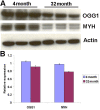Increased mitochondrial DNA damage and down-regulation of DNA repair enzymes in aged rodent retinal pigment epithelium and choroid
- PMID: 18392142
- PMCID: PMC2288587
Increased mitochondrial DNA damage and down-regulation of DNA repair enzymes in aged rodent retinal pigment epithelium and choroid
Abstract
Purpose: In the central nervous system (CNS), increased mitochondrial DNA (mtDNA) damage is associated with aging and may underlie, contribute to, or increase the susceptibility to neurodegenerative diseases. Because of the focus on the retinal pigment epithelium (RPE) and choroid as tissue relevant to age-related macular degeneration (AMD), we examined young and aged RPE and choroid, harvested from rodent eyes, for DNA damage and for changes in selected DNA repair enzymes.
Methods: Immunohistochemical labeling and quantitative ELISA for the oxidative DNA damage marker, 8-hydroxy-2'-deoxy-guanosine (8-OHdG), were measured in young and aged rodent RPE and choroid. mtDNA and nuclear DNA (nDNA) damage was determined by quantitative polymerase chain reaction (PCR) by comparing the relative amplification of small and large DNA fragments. Expression of several DNA repair enzymes was measured using real-time quantitative reverse transcription -PCR (qRT-PCR) and immunoblot.
Results: Immunohistochemical labeling for 8-OHdG increased in aged rodent RPE and choroid. Quantitative ELISA confirmed increased levels of 8-OHdG. Measurements of nDNA and mtDNA lesions indicated that DNA damage is primarily in mtDNA in aged RPE and choroid. Using qRT-PCR, we found that gene expression of DNA repair enzymes, 8-oxoguanine-DNA glycosylase 1 (OGG1), mutY homolog (MYH), and thymine DNA glycosylase were decreased in an age-dependent pattern in RPE and choroid. However, endonuclease III homolog 1 was not significantly changed in aged RPE and choroid. Using immunoblots, we found that protein levels of OGG1 and MYH were decreased in aged RPE and choroid.
Conclusions: Our results show that there is increased mtDNA damage in aged RPE and choroid, which is likely due to decreased DNA repair capability. mtDNA damage in the RPE and choroid may be a susceptibility factor that underlies the development of AMD.
Figures





References
-
- Drachman DA. Aging of the brain, entropy, and Alzheimer disease. Neurology. 2006;67:1340–52. - PubMed
-
- Burke D, Hickie I, Breakspear M, Gotz J. Possibilities for the prevention and treatment of cognitive impairment and dementia. Br J Psychiatry. 2007;190:371–2. - PubMed
-
- Rattan SI. Theories of biological aging: genes, proteins, and free radicals. Free Radic Res. 2006;40:1230–8. - PubMed
-
- Lu T, Pan Y, Kao SY, Li C, Kohane I, Chan J, Yankner BA. Gene regulation and DNA damage in the ageing human brain. Nature. 2004;429:883–91. - PubMed
-
- Martin LJ. Mitochondriopathy in Parkinson disease and amyotrophic lateral sclerosis. J Neuropathol Exp Neurol. 2006;65:1103–10. - PubMed
Publication types
MeSH terms
Substances
Grants and funding
LinkOut - more resources
Full Text Sources
Medical
Research Materials
